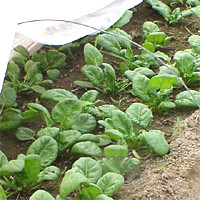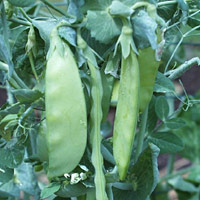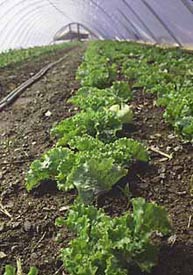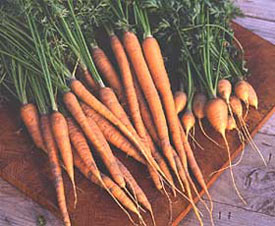
Cover your fall crop of spinach with a floating row cover to extend the harvest.
With all the produce pouring in from your garden, starting more plants or seeds is probably the last thing on your mind. However, August is a great month to start planning and planting a fall garden. It's what I call the second season of planting. Many of the vegetables you've enjoyed from the garden this spring and early summer can be planted and harvested again this fall.
Vegetables To GrowYou can grow a fall garden in all but the coldest parts of the country. The first task is to make a list of the crops that will have time to mature before your first hard frost. For most regions, the list will include fast-growing, cool-season vegetables, such as beets, broccoli, cauliflower, cabbage, carrots, collards, lettuce, mache, parsley, peas, radishes, and spinach. In warm-winter and tropical areas you can add warm-season crops, such as beans, summer squash, tomatoes, and peppers, to the list. Select varieties described as fast-maturing or adapted to maturing in cool temperatures. Here are a few good varieties to try:

Snowpeas, also known as Chinese flat-podded peas, are a good choice for fall gardens because the pods can be harvested at a young stage. Even if you don't get pea pods, the tendrils make great additions to salads.
Timing is the key to growing vegetables in your fall garden. Vegetables grown in fall need about 14 extra days to mature compared with spring-seeded crops, due to fall's shorter days and less intense sunshine. Start your planting calendar by determining your average first frost date. Usually the local weather service, cooperative extension service, or a gardening neighbor will know that date for your area. Mark this date in your calendar. Now look at each seed packet for days to maturity and add 14 days. Using these numbers, count backwards from the first fall frost date and mark the sowing dates for each crop. If you're starting seeds of broccoli, cauliflower, and lettuce in 6-packs or peat pots for transplanting into the garden, add an additional 4 to 6 weeks to account for this beginning growth period.

Many varieties of lettuce are adapted to growing in the cool weather of fall. Some of the best are 'Winter Marvel' and 'North Pole'. Growing lettuce under a plastic grow tunnel allows you to extend the harvest into late fall.
The hot, sunny weather of August is stressful to young seedlings and transplants. Before planting, add compost and moisten the soil. Plant your seeds a little deeper than normal. After planting, shade the soil -- with a scattering of straw, for example -- to keep it cool and moist. High soil temperatures will inhibit the germination of many vegetable seeds. Protect young seedlings with shade cloth or plant them on the north side of taller plants, such as corn and tomatoes, to provide shade from the hot afternoon sun.
Another option is to start seeds indoors. Good choices for indoor seed-starting are greens, such as lettuce and Swiss chard, and cabbage-family crops, such has broccoli and cauliflower. These plants prefer growing in cooler, moister conditions than those found in most outdoor gardens in August. Grow the seedlings indoors under lights, as you would in spring, then transplant them into the garden after four to six weeks. After planting, keep the seedlings well watered and use a floating row cover to protect them from intense sun and pests.
Fall Harvest
When growing carrots for fall, choose quick-maturing varieties, such as 'Kinko', or ones that hold well in the soil without cracking, such as 'Red Cored Chantenay'.
With a little effort in summer, you'll have a splendid harvest of greens, fruits, and roots in fall. Harvest heat-loving crops, such as beans and summer squash, regularly; these plants will succumb to the first fall frost. Cool-loving crops, such as kale, lettuce, spinach, peas, and broccoli, will thrive in fall's cooler weather and will withstand light frosts. You can extend the growing season further by placing floating row covers or grow tunnels over the plants, especially at night. With any luck you'll be eating from the garden until Christmas.
Some root crops, such as carrots and beets, can be harvested into winter. In fall, cover them with a 6- to 8-inch-deep layer of hay mulch. As long as the ground doesn't freeze, you'll be able to dig and eat these roots even beyond Christmas.
Plant Lettuce Now for Winter Greens
 Charlie Nardozzi is an award winning, nationally recognized garden writer, speaker, radio, and television personality. He has worked for more than 30 years bringing expert gardening information to home gardeners through radio, television, talks, tours, on-line, and the printed page. Charlie delights in making gardening information simple, easy, fun and accessible to everyone. He's the author of 6 books, has three radio shows in New England and a TV show. He leads Garden Tours around the world and consults with organizations and companies about gardening programs. See more about him at Gardening With Charlie.
Charlie Nardozzi is an award winning, nationally recognized garden writer, speaker, radio, and television personality. He has worked for more than 30 years bringing expert gardening information to home gardeners through radio, television, talks, tours, on-line, and the printed page. Charlie delights in making gardening information simple, easy, fun and accessible to everyone. He's the author of 6 books, has three radio shows in New England and a TV show. He leads Garden Tours around the world and consults with organizations and companies about gardening programs. See more about him at Gardening With Charlie.
 Victory Seed Company has all the seeds you want for your best garden in 2024.
Victory Seed Company has all the seeds you want for your best garden in 2024.
For 25 years, the family-owned Victory Seed Company has provided the highest quality vegetable, herb and flower seeds to families across the country. We are passionate about providing you the best seeds available that give excellent germination, robust plants, and the harvest you want. With a catalog of over a thousand varieties, we have everything, and our prices are the kinds that we'd want to pay. We have hundreds of yesterday's heirloom vegetables, as well as today's award winning hybrid selections. Get to know us by visiting our website and browsing through our online vegetable seed catalog.